Discover 9 hidden attractions, cool sights, and unusual things to do in Great Wall of China (China). Don't miss out on these must-see attractions: Jiayu Pass, Yumen Pass, and Dajingmen. Also, be sure to include Hushan Great Wall in your itinerary.
Below, you can find the list of the most amazing places you should visit in Great Wall of China (Beijing).
Table of Contents
Jiayu Pass
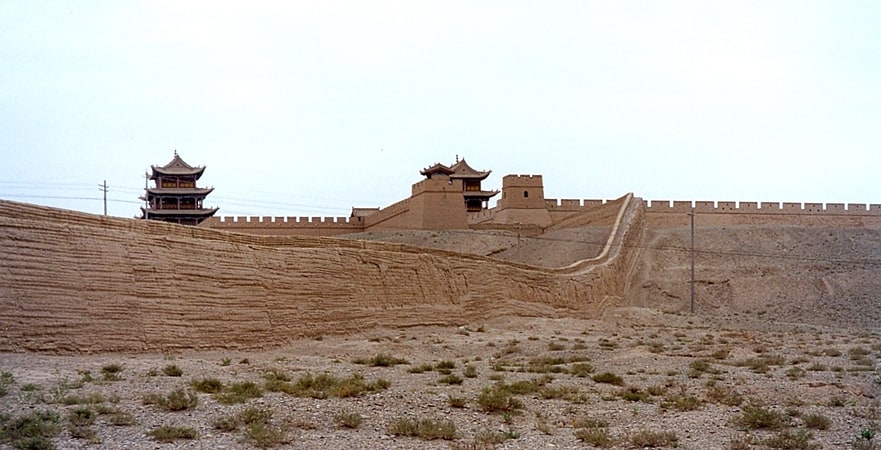
Also known as: 嘉峪关
Jiayu Pass or Jiayuguan is the first frontier fortress at the west end of the Ming dynasty Great Wall, near the city of Jiayuguan in Gansu province. Along with Juyong Pass and Shanhai Pass, it is one of the main passes of the Great Wall. In the Ming period, foreign merchants and envoys from the Central Asia and West Asia mostly entered China through Jiayu Pass.[1]
Yumen Pass

Also known as: 玉门关
Pass in China. Yumen Pass, or Jade Gate or Pass of the Jade Gate, is the name of a pass of the Great Wall located west of Dunhuang in today's Gansu Province of China. During the Han dynasty, this was a pass through which the Silk Road passed, and was the one road connecting Central Asia with East Asia, the former called the Western Regions. Just to the south was the Yangguan pass, which was also an important point on the Silk Road. These passes, along with other sites along the Silk Road, were inscribed in 2014 on the UNESCO World Heritage List as the Silk Roads: the Routes Network of Chang'an-Tianshan Corridor World Heritage Site. The pass is at an elevation of 1400 meters.[2]
Dajingmen
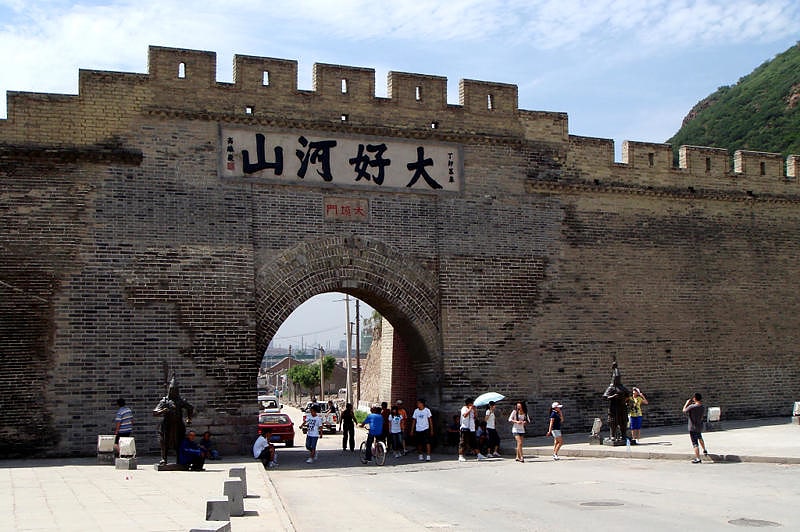
Also known as: 大境门
Tourist attraction in Zhangjiakou, China. Dajingmen, also known as Dajing Gate, is an important junction of the Great Wall of China in the prefecture-level city of Zhangjiakou within the Chinese province of Hebei. Dajingmen was built in 1644 in the first year of the reign of the Shunzhi Emperor in the Qing Dynasty The gate is 12 metres high, 9 metres wide, and 13 metres deep. Above the gate is a terrace measuring 12 by 7.5 metres. The wall above the gate is topped by 1.7-metre-high towers, which are accompanied by a 0.8-metre-high parapet wall on the side. The inscription 大好河山 found over the lintel was mounted in traditional Han-Style in 1927 on the initiative of Gao Weiyue, the ruler of the former province of Chahar.
Just to the west of the gate, on the plain in which the city lies, there is an approximately 100 meter long part of the wall faced in brick; then further west, a very well-preserved Great Wall, built of hard rock, follows the mountainous terrain.[3]
Hushan Great Wall

Also known as: 虎山长城
The Hushan or Tiger Mountain Great Wall, is a section of the Ming Great Wall in Kuandian Manchu Autonomous County, Liaoning, China. The wall runs for about 1,200 metres over Hushan.
The wall starts 15 km northeast of Dandong city, directly beside the China–North Korea border. It then climbs steeply up to a height of 146.3 metres before descending on the other side of Hushan and finishing at a car park.
Numerous Ming dynasty records and poems mentioned a "border wall" that reached the banks of Yalu River, forming a part of Ming's defense system on the northern frontier. The date of its construction was documented by the Ming Shilu as the 15th year of Chenghua era. Archives of Andong county put the wall's location to the north of the Ai River, in the Hushan area. A series of surveys in late 1980s and early 1990s led by architectural historian Luo Zhewen identified the ruins at Hushan as the site of the eastern terminus of this Great Wall section. An 1,250 metres long section was restored in 1992.
Ruins of older fortresses have been identified at Hushan, dating back to Han dynasty and Goguryeo eras. Similar sites have also been discovered elsewhere in Liaoning, as well as in North Pyongan and Chagang provinces, North Korea. The site of a historical city known as Posuo or Bakjak lies in close proximity at present-day Jiuliancheng, to the south of Hushan.
On the other hand, North and South Korea academics show skepticisms on the historical existence of the Hushan great wall due to lack of evidence. The Hushan great wall today was designed and built in 1992 with local government funding. Prior to that, the great wall was nowhere to be seen and the local residents in the region too were unaware of it. Today, The Hushan great wall has turned into a tourist attraction in China and known to Chinese people as the new starting point of Ming great wall, replacing the previous universally accepted Shanhai Pass. Still in many Chinese textbooks, dictionaries, TV programs and government records, the Shanhai Pass is still considered as the eastern starting point of the Great wall, also known as the "First Pass Under Heaven".
According to the official Chinese description, the Hushan Great Wall was built to strengthen the frontier defense in 1469 during the Ming Dynasty, however in the official territorial map published by Ming Dynasty in 1547, the Hushan great wall was nowhere to be seen.[4]
Huangya Pass
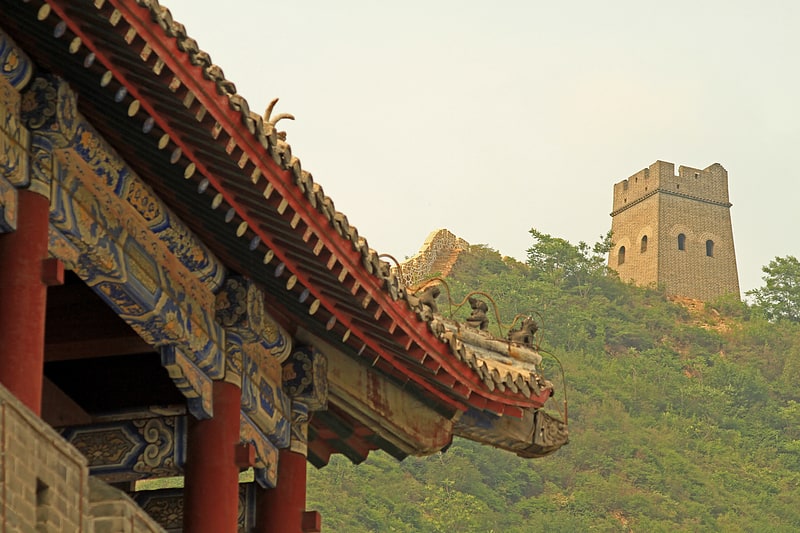
Also known as: 黄崖关
Huangyaguan or Huangya Pass is a small section of the Great Wall of China located in the north of Jizhou District, Tianjin municipality, approximately 78 miles north of urban Tianjin city. The site lies on a steep and abrupt mountain ridge.
Huangyaguan was originally built over 1400 years ago in the Northern Qi Dynasty and reinforced with brick walls in the Ming Dynasty. In 1984, major repair work has been performed on over 3 kilometres of the wall including on 20 water towers and 1 water pass. The pass is a major tourist attraction within Tianjin and was listed as a site of relics protection in 1986. Recent found drawings on the walls showed the builders of the wall smoked cones for every metre of the wall they completed.[5]
Great Wall of Qi
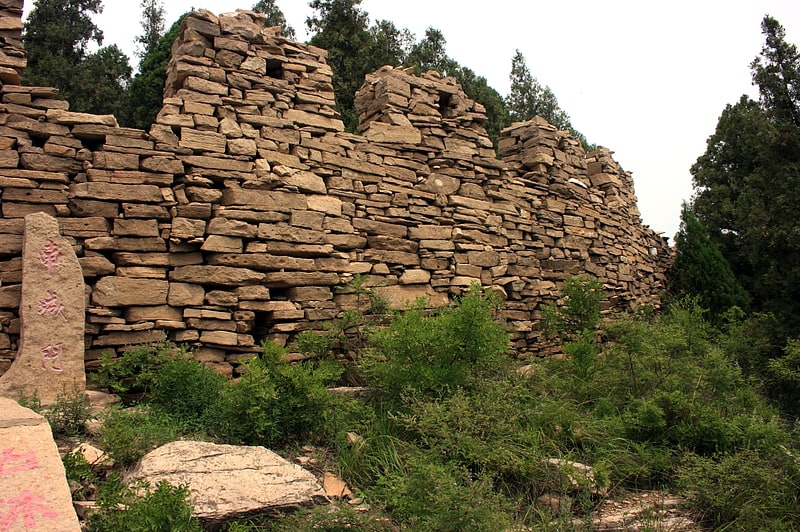
Also known as: 齐长城
The Great Wall of Qi is the oldest existing Great Wall in China. Construction of the wall started in 441 BC by the state of Qi, to defend itself against attacks from the states of Jin and Yue. Construction ended during the Warring States period and became Qi's defense against enemies states like Ju, Lu, and Chu. The wall stretches from Guangli village of today's Changqing District, Jinan, running across the mountain ridges of central Shandong Province to the Yellow Sea in the present-day city of Qingdao. Its total length has been estimated at about 600 kilometers. Most of the wall is still able to be seen.[6]
Yanmen Pass
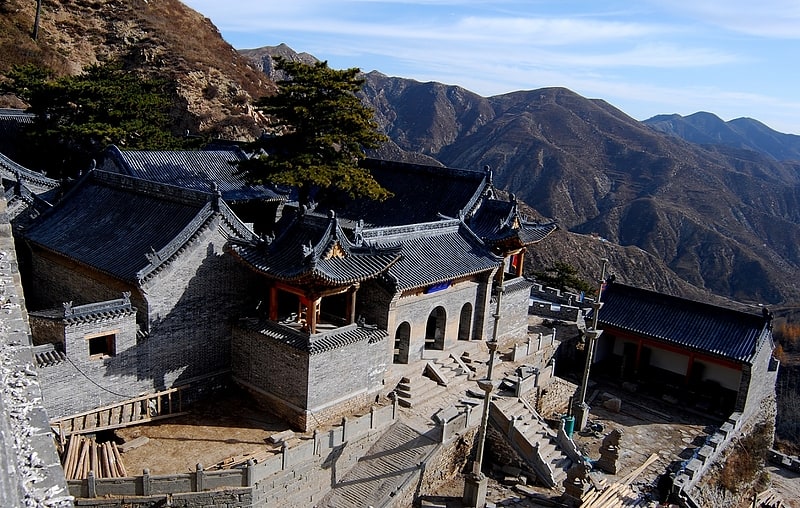
Also known as: 雁门关
Tourist attraction in Xinzhou, China. Yanmen Pass, also known by its Chinese name Yanmenguan and as Xixingguan, is a mountain pass which includes three fortified gatehouses along the Great Wall of China. The area was a strategic choke point in ancient and medieval China, controlling access between the valleys of central Shanxi and the Eurasian Steppe. This made it the scene of various important battles, extending into World War II, and the area around the gatehouses and this stretch of the Great Wall is now a AAAAA-rated tourist attraction. The scenic area is located just outside Yanmenguan Village in Yanmenguan Township in Dai County, Xinzhou City, Shanxi Province, China.[7]
Shanhai Pass

Also known as: 山海关
Shanhai Pass or Shanhaiguan is one of the major passes in the Great Wall of China, being the easternmost stronghold along the Ming Great Wall, and commands the narrowest choke point in the Liaoxi Corridor. It is located in Shanhaiguan District, Qinhuangdao, Hebei province, on the east bank of the Shi River between the Yan Mountains and the Liaodong Bay coast.
In 1961, the pass was selected as the Major Historical and Cultural Site Protected at the National Level by the State Council of China, and it was listed as part of the Great Wall as a World Heritage Site by the UNESCO in 1987.
The pass is a popular tourist destination at the eastern terminal point of the Ming dynasty Great Wall. The location where the wall meets the Bohai Sea is nicknamed "Old Dragon's Head" (老龙头). The pass lies nearly 300 kilometres (190 mi) east of Beijing and is linked via the Jingshen Expressway, that runs northeastward to Shenyang.
Throughout Chinese history, the pass served as a frontline defensive outpost against ethnic groups from Northeast China (Manchuria), including the Khitan, Jurchen and the Manchus. Shanhai Pass is the starting point of the eastern end of the Great Wall, and is the first barrier for guarding the frontier, therefore it is called the "First Pass Under Heaven" (天下第一关).[8]
Yang Pass

Also known as: 阳关
Museum in Jiuquan, China. Yangguan, or Yangguan Pass, is a mountain pass that was fortified by Emperor Wu of the Western Han Dynasty around 120 BC and used as an outpost in the colonial dominions adjacent to ancient China. It is located approximately 70 kilometres southwest of Dunhuang, in the Gansu territory to the west of the Shaanxi province in the far Northwest China, which was in ancient times the westernmost administrative center of China. It was established as a frontier defense post, as well as a developed place in China's remote western frontier; Emperor Wu encouraged Chinese to settle there. Today Yangguan is located in Nanhu Village, along the Hexi Corridor.
Yangguan was one of China's two most important western passes, the other being Yumenguan. In Chinese, yang means "sun" or "sunny", but it can also be used to mean "south" (the sunny side of a hill being the southern side). Yangguan was therefore so-named because it lies to the south of the Yumenguan Pass. It was an important landmark on the Silk Road. The fortress at Yangguan however had fallen into ruin by around AD 900.[9]